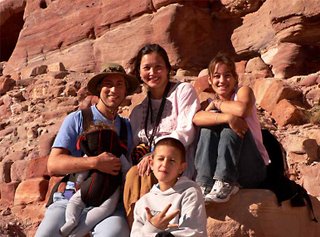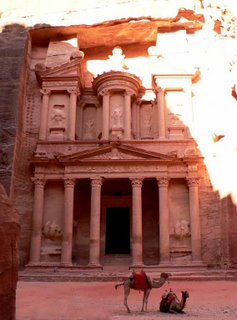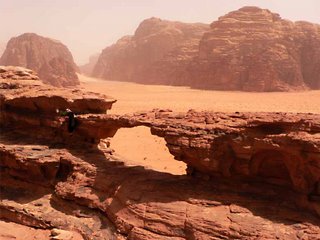
Jordan – Land of Many holy sites
Dear Friends,
We love hearing from you and appreciate your encouragements. See our web site for previous writings and pictures about our journey that you haven’t seen before– www.gabriel-icasiana.com
We love you, Gabriel and Icasiana and the family
Funny entry into Jordan
I must tell a funny story about our trip crossing the border from Syria into Jordan. It starts with us getting a minivan from our hotel in Sednaya, Syria to Damascus where we intend to hire a taxi to drive us across the border into Jordan, only about 60 kilometers away, then we’ll continue on to Amman, Jordan, another 80 kilometers We also wanted to visit the ancient Roman ruins of Busra which was on the way, sort of. This site was near the Syrian/Jordanian border but about 40 kilometers east off of our route. When we arrive in Damascus, I proceed to the area where many taxis are located to negotiate with a driver to get a ride. I was practically attacked by a mob of eager drivers all talking to me at once, except they were talking to me in Arabic. There was one driver who could speak some English and we finally came to an agreement on the price after an intense negotiation, but when he showed me his taxi, it was a small car. I decided that it would be too small because we have a lot of luggage. We’re traveling for a year and it looks like it. So now I was bombarded again with drivers talking to me in Arabic, and they’re talking amongst themselves, and a young man is presented to me but he wants a lot more money than I had already agreed to. I stood firm and eventually he agrees. His car is all the way on the other side of this terminal though, and our previous driver helps us to get there, except he and our new driver have made an arrangement to drive further down the road where they can make an exchange. I don’t know where we’re going and I’m feeling all out of control. When we finally arrive at the rendezvous spot, lo and behold, his car is the same size as the first one I’d spoken to who spoke English. This driver speaks only a little bit more English than I speak Arabic and I speak about 2 words. Hello and thank-you. I learn those 2 words in every language and get through a lot, and gesticulate for the rest.
In order to get across the border, our driver needs to cross it before 3 pm, or his taxi turns back into a pumpkin. He is from Syria and is not allowed to cross into Jordan after 3 pm. We have negotiated this factor into our planning for our trip. So we start out on our drive. He drives like an absolute maniac, really fast. We’re traveling for a bit and then he says he needs to stop at his home which is on the way. When we get to his village, he invites us into his home. We know it’s not impolite to refuse an Arab’s offer of tea, we also know we have a limited time to get to the border. We sit in his home, he is Muslim, we meet his wife, and other family members. She is dressed in the traditional garb, and she is covered from head to toe except her face. There is a picture of Mecca in Saudi Arabia on their wall, and the room is modest, but very lovely in its simplicity and comfort. Instead of tea, we are served Fanta, Icasiana drinks mine because she knows I got my fill of soda as a child and don’t need anymore. We are sitting in this room with the women covered and on the TV is a music video of scantily-clad women belly dancing, but not quite belly dancing, more like music video dancing in an Arabic style. I liked it, but it was so bizarre, the dichotomy between the strict Muslim women all covered in front of us, while on the TV were modern Arabic women uncovered. Anyway, after 30-45 minutes we leave his house and continue on our drive. And now, he’s driving faster than before and I finally tell him to slow down, Icasiana is beginning to lift off the seat on every bump. And I won’t even mention the swerving and near misses.
We see the ruins of Busra which is filled with its own bizarre qualities of unexpected happenings. We hire a horse and buggy to take us through the ruins and we tell him we have to be back at 2pm, as our driver has instructed us, so we can be ready to resume our journey to the border and get there in time. So we’re rushing through this site and we get back in time and into our car, and he starts driving, but now he’s driving real slow and murmuring something about we won’t be able to make it.
Then he tells us we won’t make it in time, or that’s what I think he is saying/gesturing. What is going on here? We told him from the beginning what we wanted, we got back from the ruins when he told us to, he had taken us to his home for 40 minutes, and now we don’t have time to get across the border. Okay, I’m starting to get pissed. And I’m raising my voice to him and speaking with emphatic gestures, except I’m speaking English, and as already described. He doesn’t. So we try to call Zaki our friend in Damascus, but his phone is dying. And just when I reach him, our driver has left the car to ask a question somewhere. I overhear him explaining to someone about how he had to go to Busra and then this and that and whatever. I’m sure he never mentioned that he stopped at his house for 45 minutes, longer than we were at Busra.
Now I realize this story is getting very long, and it’s much ado about nothing, I’m here now to assure you, it’s almost over. Our driver informs us he can’t take us over the border, it’s too late. He then takes us to a place unknown to us is where Jordanian drivers come to get passengers stranded like us. I’m angry because I think we’ve been duped and I’ll have to pay an additional fare to get to where we’re going. In the end we’re all smiles because he has worked out an arrangement with the new new driver from Jordan where they split the fare and I pay no more. And that’s the happy ending to this little farce.
Welcomed in Jordan
The word we have heard the most in Jordan as it was in Syria is “Welcome”. This is how I have felt received here by the people. The people we have met have treated us well and have shown caring good hearts. The Arabs and Bedouins come from an ancient culture of hospitality and that way of living is still intact. One evening while driving in a taxi, the driver told us he has met many Americans, and they were very nice people. He politely communicated his lack of appreciation about our government though. He was able to make a distinction between governmental policies and actions, and the heart of a people.
A number of people in Jordan mentioned to us about how safe Jordan is. We were told that police are always watching out for the safety of tourists. If anyone from Jordan should bother a tourist in any way, and it was seen, or there was a complaint, they will be arrested and vigorously investigated. They would probably end up in jail. We have also heard a number of laments from the people in Syria and Jordan about how the Western media has portrayed them unfairly and how the Middle East is unjustly portrayed as dangerous. As we have found out, this is not true. It is very safe here, very relaxed and stress free. There are also many ancient sacred holy sites in these areas that are treasures of the world.
Sacred Sites of Jordan
Based out of the city of Amman, we hired a driver by the name of Jamal and that allowed us to cover a lot of ground and see an extraordinary amount of ancient holy places. Places we saw are described in the Bible. We saw 4 places in Jordan to mention: 1) Um Queiss in the North of Jordan. These were ancient ruins of the Romans and Byzantine, as well as the Ottomans of Turkey. It looked out over the Golan Heights to the north, the Sea of Galilee to the northwest, and Israel further past the Sea. We visited 2) Jerash which has some of the best preserved ruins of the Roman Empire in the world, they said. One noteworthy item to mention is what happens when you stand in the center of the amphitheatre stage, there is a sweet spot right in the center where one’s voice is magically amplified in a beautiful resonant tone. (Frankly, I’m not that interested in the Roman culture, what they lived for and how they demolished other cultures to create the same types of buildings wherever they went. They did know how to build though). We went to 3) Mar Eliyas, which is an elevated site overlooking the Jordan valley. It is reputed to be the place where the prophet Eliyas (Elijah) was born. This place was very charged and alive, and was a wonderful place to sit and soak up the ancient field and wonder. We also went to 4) Mt. Nebo. It is said to be the birth place and burial place of Moses. From one of the vantage points, Jerusalem, Bethlehem, Jericho and the Dead Sea can be seen. This is also the spot that Moses is said to have overlooked the holy land when he led the Jews out of the desert, after their forty years of wandering, but would not reach himself. They have reconstructed a temple on this site that was very powerful. They had laid out the old church stones into the ancient configuration and constructed a modern day roof. The effect was to contain the energy of the stones. I stood there feeling a charged streaming energy coming into my body. I found it ironic that this site, the place of Moses, was honored by a Christian church and artifacts, yet not a mention of his Jewish roots. There is a very strong Christian presence in history on this land. The Arabs were Christian before Islam was brought to the world by Mohammed. Jews lived in these lands a long time ago, but I don’t know how large their presence has been since then.
Petra - A Jewel from Ancient Times


The jewel of the sites in Jordan for us was definitely Petra. Petra is located in a canyon that was formed by millions of years of water carving out the rocks. The stones are gorgeous colors reminding me of the Grand Canyon or the Painted Desert of Arizona. Without any buildings in this area this place would be worth seeing, just to walk through this awesome canyon. In addition to this unique canyon though, the ancient Nabateans, dating back to the 6th century BCE built astonishing structures here. They carved them out of the rocks here, and they are exquisite. This is a crowning achievement, an example of how to build in harmony with nature, of enhancing what is already magnificent, and adding to the gloriousness of the natural world. They must have been a very beautiful people to have built in this way. I would love to have met them and know more about them. What a masterpiece! The kids were even pretty impressed, but more so, they were impressed by the names of the donkeys we rode to the stone museum...Jamal, John and, of course, Jack (yes, you know, Jack-Ass).
Wadi Rum- Bedoiuns in the Desert


After Petra we went to the desert of Wadi Rum (Wadi means valley) and stayed overnight in a Bedouin camp. We had the idea it would be the home of a family or a group of families. It is just a shell of a campsite, they do not live there, they just come to prepare it for visitors. We were very briefly in the desert and after a long trip to Petra, there was little energy to revel in the desert’s night magic, and we all went to bed early, missing the full moon and the mystical sounds of the desert. The best part is we met a mother-daughter duo traveling from Illinois and a lovely woman from Madrid, Spain. We got a little taste of the desert and I marveled at how these people live this way, and how strong they must become mentally to be here, and thrive here.
On our way back to Amman, from where we would travel by bus into Israel the next day, we stopped at the Dead Sea and floated in the salty water and marveled at this lowest place on the earth. These are powerful healing waters; most of us broke out in some kind of healing rash for a day. This, of course, is after we slathered our bodies with the dead sea mineral-rich black mud. Elijah started to do his kick-kick, paddle-paddle, swimming routine but we had to stop him because of the concern of getting the water in his eyes. The salt burns intensely if it gets in the eyes. We were told the water that comes from the Jordan River into the Dead Sea has no outlet because it is so low in elevation. As a result the water evaporates and leaves the water more and more concentrated with salt.
Palestinian Heartbreak
During our time in Jordan we have met many Palestinian people and have had such a nice connection with them as they are wonderful and generous people. We had the chance to hear their stories, and learn about their suffering and loss of their land and homes. We also went to a bookstore to explore the issues of homeland and peace in Israel/Palestine. What I’ve heard has started me questioning the things I have believed for a lifetime about Israel and the West Bank. For now I will just say that I have come to realize that there were people who lived in the land of Israel when it was known as Palestine, or Transjordan, or whatever it was known as. They were indigenous people who farmed and lived off the land, cultivated olive trees, fig trees, oranges trees, and raised all kinds of crops, goats, and sheep. They lived here for many generations, hundreds if not thousands of years and when the Jewish homeland was formed, when the Israeli state began, they were forced off the majority of the land. Many of them left on their own, but most of them were forced off their land and became refugees. We were told that 70% of all Arabs now living in Jordan are Palestinian refugees. I have come to believe that they have a valid right to this land, their suffering has been real and they deserve to be recognized for their plight.
Now we’re onto Israel, feeling shaky.

No comments:
Post a Comment